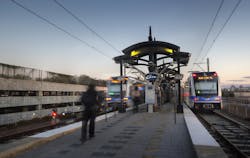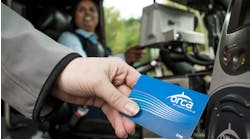Infrastructure drives economic growth. That’s what John Lewis, Charlotte Area Transit System (CATS) executive director said he observed when he first started his career, working on Capitol Hill for Senator Barbara Mikulski, D-Md., doing appropriations work.
“I started to, right out of college, understand what infrastructure, particularly investment in infrastructure, had throughout our economy,” he said. “Moving freight, moving people, it really was a foundation for our economic strength.”
He saw that further when he went worked for former Maryland Secretary of Transportation John Pocari. After 5 years on Capitol Hill he got frustrated with the pace of change so went to work for the Maryland Department of Transportation, where the governor at the time, Parris Glendening, was very focused on smart growth.
At the state level, Lewis got a detailed view of how the state used infrastructure investment to drive economic growth. “Where we built roads, where we invested in transit, where we invested in water lines, it really had a huge impact on where development occurred.”
Background
For Lewis, diverse experiences at several transit agencies gave him the foundation he uses in planning for the future.
His first transit agency position was with the Maryland Transit Administration, after working at the MDOT. He went to work at MTA on a Monday and on that Thursday they had their first incident of wheels falling off of buses — literally, rear wheels coming off of the vehicles. He said within a 7 or 8-month period, they had about 25 incidents.
“The agency was in turmoil,” said Lewis. Every wheel was replaced, every brake assembly was replaced, every nut, bolt, everything they could think of was replaced and they didn’t know what the issue was. “We were having fights in the yard,” he said. “Everyone above me got fired at one point or the other,” he continued. “You can imagine the impact that it had on morale.”
The other impact the incidence had was that it gave Lewis the crisis management, team building experience that has helped him in his career. “It was absolutely trial by fire,” he said. “That helped me in my career but that was not a fun time.
“We got through it and we learned some valuable lessons both as an agency and personally from a management standpoint.”
As for the wheels, at one time the wheels were made of steel and in order to keep them from rusting together, a synthetic spacer was put between them. Over the decades, wheels were changed to aluminum, which don’t rust. However, the spacers were still there. After a period of time, the spacer would deteriorate, causing the wheels to bump together, leading to a catastrophic failure. The spacers were thrown away and the problem was eliminated.
After several years with MTA, Lewis had the opportunity to lead the GRTC Transit System in Richmond, Virginia. It was a smaller, bus-only system, but he couldn’t pass up the opportunity to be the chief executive officer. He said he enjoyed his time there and they did some incredible things and also finds it interesting meeting the number of general managers and CEOs who spent time there at one point in their career. “There are about 10 of us,” he said. “Myself, Keith Parker, Matt Tucker, Paul Ballard, I mean the list goes on and on. That small transit authority has been a training ground for a lot of us.”
From Richmond Lewis went to Orlando, to work at Lynx. From Baltimore to Richmond and Orlando, transit is seen very differently and there were challenges in getting the resources necessary to operate a system to meet the demand.
Lynx covers more than 2,500 square miles within three counties. And they provide that service with 300 vehicles an no dedicated revenue source. Some of the routes, he described, would start in downtown Orlando and end up in cow fields. Half of the routes were hourly headways yet they still moved more than 100,000 people a day.
“The challenge of planning routes that operate in three very distinctive areas with very different needs was challenging,” he stated.
There was a critical moment that Lewis described. There was a positive article about an amazing young woman in the Orlando Sentinel paper. She had been a recent immigrant to the country and had worked her way through high school, gained a full-ride scholarship to a university, and was a straight A-student the entire time.
“The whole article was lauding her accomplishments,” explained Lewis. “But there was one line at the end of the article that really brought it to light for me.
“It said her daily commute on transit was four hours. And I said that no matter what I think I’ve accomplished here, that’s unacceptable and I don’t know how to fix it.
“Funding for transit and growth of transit is significantly behind. How do I as a transit executive look and say we are doing a good job to somebody that it takes them four hours to get from home to work, from work to home in a tier 1 city … it was 11 miles if I remember correctly.”
As executive director of CATS, he appreciates leading the transit system in a city that understands that.
Charlotte Progress
Lewis was attracted to the Charlotte area because they recognized growth was coming and in 1998 and developed a plan to provide multifaceted multimodal transportation to its citizens.
Director of Marketing & Communications Olaf Kinard explained there was a shift in the 90s and city leaders recognized they couldn’t keep growing the way they were growing. The planning director at that time had come from Portland, Oregon, and along with other city leaders, knew if they wanted to be a world-class city moving forward, they needed to do more than building roads and widening roads.
“This region thinks very differently,” Lewis explained. “They developed a very specific plan for that [growth] and put the resources necessary in a half-cent sales tax at that time to build out the system.”
Though they’ve not been without obstacles. Kinard shared that about a month before they opened the Blue Line, some anti-transit folks did a petition and was able to get on the ballot on whether to rescind the tax or not. “Seventy percent of the Mecklenburg County voters re-approved the transit tax.” Kinard stated.
The biggest issue, he said, is that people want rail everywhere.
Lewis explained that the region grasped early on that transit is an integral part of not only transportation options, but is also a spur for economic development. There’s been one-and-a-half billion dollars in new development that has occurred along the Blue Line and there is more being planned and under construction along the extension.
“That investment along the Blue Line has really revitalized that corridor,” said Lewis, “and it continues to be a place where people want to be.”
As you ride on the line, there’s new apartments and offices and a lot of new buildings under construction.
“When you look at the amount of activity along there … people taking the train, people walk along there. It’s almost become a green trail. It’s an asset to the community, not just an infrastructure investment.”
When it comes to ridership, the line has been open a little over 8 years and it’s reaching close to its 2020 ridership projections. Pamela Seward-White, principal planner, said, “In opening year annual ridership was about 8,000 [annual] trips and since opening, we’ve averaged about 15,000.”
Successful Transit
When asked about what makes CATS successful in the region, Lewis said that No. 1 is collaboration. “In this building you will have county government, city government and the operating agencies. There’s a huge amount of collaboration.”
He elaborated, “We don’t have to go somewhere else to have a meeting. It is easy to see my colleagues from the county, from the city, in the elevator, in the lounge downstairs; there’s a huge amount of collaboration that goes on. That tends to be a little bit more difficult than other regions.”
All of the local entities are at the table when there are discussions about county and city goals and long-term land use. Lewis said it makes it easier when you’re sitting at the table at the beginnings of these discussions and when you are fortunate to have the informal collaboration that goes on, early on. “It allows us to come up with a very focused strategy in regards to development, land use and how transit will become a part of that.
An example of this was a trip to Washington, D.C., to meet with the Federal Transit Administration about the new transit-oriented development program. “Sitting there as a transit agency with the mayor, the mayor pro-tem, with other departments, we got to hear it and start developing a unified strategy on that,” said Lewis. “Not just how I move people, but how that investment in the second phase of the streetcar can then help spur the city’s economic development and other goals.
“I think Charlotte, in a nutshell, has got right is its level of collaboration,” Lewis said. “It’s getting the right people around the table at all levels of government. Coming up with a shared strategy.”
Growth for CATS
There’s a lot going on for the future of CATS, including new fareboxes, the Blue Line extension and the CityLynx Gold Line streetcar extension.
Kinard said their fareboxes are 17 years old but they are being replaced with Genfare fareboxes this year. He said they’ll have the foundation for not just magnetic and cash, but mobile payment and contactless cards. They’re also in discussion with universities about how to have the transit app inside their student ID so students can simply tap and go.
The Blue Line extension is scheduled to open August 17, even though the full funding grant agreement opening date is March of 2018.
CATS partner, the University of North Carolina Charlotte, where the line terminates, wants it to open when school opens this fall, so that is the goal.
The agency learned a lot from the initial segment and one of the keys was collaboration. “Where I’ve had problems in the past, I’m a transit agency,” explained Lewis. “If I want to build something, I normally bring in a consultant group. I’ll bring in some engineers, but they’re all outside working on my project. It works well, it happens.
“Here, we have a public works department, an engineering department that builds lots of things,” he continued. “I can go upstairs to my colleague … the head engineer for the city, and say, ‘Look at our plans, how can we do this better, what can we do?’”
This project is a bit different than the first in that there are two contractors working on the civil side, the dirt and construction of the project, to put a little bit of competition in that. Lewis said one contractor doesn’t want to have another one finishing faster or better.
Blue Line Extension: Northeast Corridor
9.3 miles
11 stations
4 park-and-ride stations
Estimated project budget: $1.6B
CityLynx Gold Line
Phase 1
Opened July 2015
1.5 miles
Phase 2
Opens 2018
2.5 miles
CityLynx Gold Line: Engine for Economic Growth
1.1M or more square feet in new development
731 additional residential units
21,800 additional sq ft of retail
276,700 additional sq ft of office space
101 additional hotel rooms
2,000 small businesses will be accessible within ¼ mile of the CityLynx Gold Line
There’s also collaboration with the freight railroad, Norfolk Southern. A lot of the alignment operates within or alongside Norfolk Southern’s right of way and they have been partners in allowing CATS to do construction during windows of time without impacting their business.
The Role of Transit Leaders
The shared economy is having an impact on public transportation and Lewis sees it as an evolution of how transit is moving into the future. It’s an opportunity to grasp, to find creative ways to partner with transportation network companies (TNCs), such as Uber or Lyft, to meet the needs of customers and to help transit improve efficiency.
“They’re not taking away our commuters, our bread-and-butter,” said Lewis. “Our morning trips during peak periods are continuing to grow. Where they are having an impact are the entertainment trips … others provide a very favorable option for that.”
Lewis explained that public transit agencies move large numbers of people along certain corridors very well, but where they lose efficiency is getting into a neighborhood to pick up a few people; agencies can’t send a bus route into every community, every neighborhood, but that doesn’t mean those people don’t need mobility options.
What Lewis would like to see as the transit system of the future is for transit agencies to find a way to partner with the TNCs to reach those neighborhoods and bring them to the transit service to let transit agencies do what they do best: move large numbers of people.
Lewis said, “I think we can find that equilibrium that provides efficient and effective transit options for its citizens, but allows us to operate in a much more effective manner. A cost-effective manner. But there are lots of challenges to get there.”
Change doesn’t come without challenges. Regulations and equal opportunity are two of the challenges when it comes to partnering with TNCs.
One challenge to solve is that many transit-dependent people don’t have relationships with financial institutions; they can’t access Uber or Lyft. “Nationally, 10 percent of Americans don’t have a banking relationship,” explained Lewis. “Twenty percent or more of Americans don’t have a credit card. I would imagine if you brought that down … to core transit-dependent riders, those numbers are probably a little bit higher.
“We’ve got to be able to bridge that digital gap for them in order to allow them to have greater access to mobility options.”
Lewis pointed out that partnering with the TNCs is also an example of how the industry needs to have conversations with the FTA on changing rules, tweaking regulations to allow agencies to be more innovative.
How do you enter into a partnership with a TNC that doesn’t penalize you from a ridership standpoint?
“If I can act as a facilitator of your trip, and in some cases a subsidizer of that trip to some extent, but you never step foot on a CATS train or bus, why shouldn’t I get credit for that?” asked Lewis. “Federal grants, for a large part, are based on ridership. We’ve got to ask that question.”
And there are other questions the industry is facing. There are other innovative partnerships transit agencies could develop, but there needs to be federal support.
In Charlotte there’s a variable pricing lane that is under construction. Are there new ways in which transit agencies could be equity partners with the highway agencies? Lewis proposed as an example, if CATS had gotten New Starts money from the FTA to partner in that new lane capacity, helping move cars faster, providing a BRT lane to move more people, getting results on Day One and as those bonds get paid off, the agency becomes a partner with each of those cars paying tolls.
“I think it’s those types of partnership in the future that are going to allow us to build additional facilities, because the old system just doesn’t work anymore,” said Lewis. “Nobody has enough money.”


